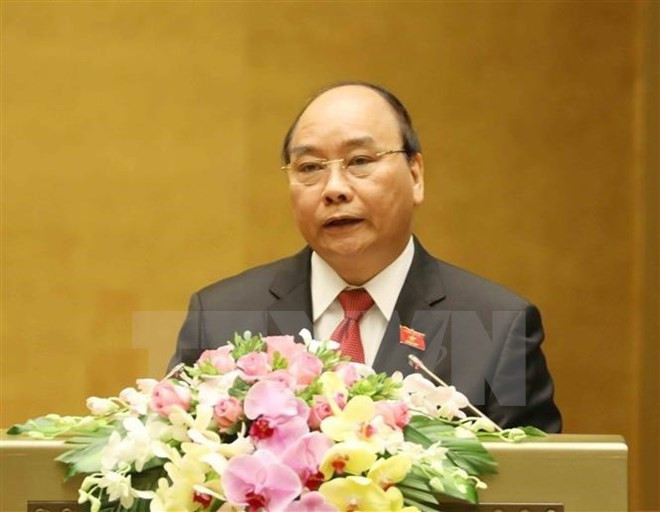 Prime Minister Nguyen Xuan Phuc addresses the fourth session of the 14th National Assembly (Photo: VNA)
Prime Minister Nguyen Xuan Phuc addresses the fourth session of the 14th National Assembly (Photo: VNA)Hanoi (VNA) – Vietnam is likely to fulfil all 13socio-economic targets set for the whole year, backed by the economicperformance in the first nine months of 2017, said Prime Minister Nguyen XuanPhuc at the fourth session of the 14th National Assembly that openedin Hanoi on October 23.
Of the targets, five are expected to exceed the plan, including tradedeficit, which is forecast to stand at only 1.5 percent compared to 3.5 percentas planned. Total development investment is likely to reach 33.42 percent ofthe GDP instead of 31.5 percent set earlier.
At the same time, exports growth is to hit 14.4 percent, doubling theset target of 6-7 percent. Total number of hospital beds will be raised to 25.7beds per 10,000 people against the set goal of 25.5 beds, while healthinsurance coverage is hoped to reach 83 percent against 82.2 percent, said thePM.
The PM reported that average consumer price index rose 3.79 percent inthe first nine months of this year and about 4 percent in the whole year, with basicinflation standing at about 1.6 percent. GDP growth in the first nine monthsreached 6.41 percent, and the figure for 2017 is about 6.7 percent. Meanwhile,poverty ratio as calculated by the multidimensional approach dropped 1-1.5percent to about 6.7-7.2 percent.
He held that this is a great success of the country, especially in thecontext that Vietnam is transforming its growth model towards reducing theexploitation of natural resources and strengthening the processing industry,high technology agriculture as well as services and tourism.
The Government leader also sketched out specific goals for 2018,including GDP growth of 6.5-6.7 percent, with average consumer price index of about4 percent.
Total export revenue is set to expand by 7-8 percent, while tradedeficit is expected to stand at below 3 percent. In 2018, developmentinvestment of the whole society is hoped to be about 33-34 percent of the GDP.
Meanwhile, the PM also set targets of curbing the poverty rate by 1-1.3percent averagely and 4 percent in poor districts, and keeping unemploymentratio in urban areas at below 4 percent.
In 2018, the percentage of trained labourers is expected to reach 58-60percent of the total workforce. The ratio of social insurance card holders isexpected to hit 85.2 percent of the population.
The country will also strive to have 88 percent of industrial parks andexport processing zones having concentrated wastewater treatment systems, andforest coverage of 41.6 percent.
In order to complete the targets, the PM also outlined five majorsolutions, including strengthening macro-economy stability, ensuring balance ofthe economy, and speeding up business and production as well as economicgrowth.
The PM also pointed to the need to restructure the economy in asynchronized, comprehensive and practical manner, along with making activeresponse to climate change and disasters, environmental protection and naturalresources management.
He also highlighted the necessity of building an effective anddisciplinary administrative system and drastically fighting againstcorruption.-VNA




























